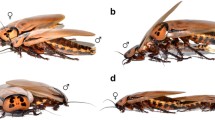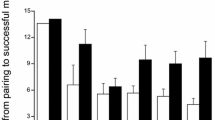Abstract
Because a trade-off between reproduction and dispersal has been commonly found in wing-dimorphic insects, males of different wing morphs may have a different demand on a mate or a territory. We hypothesized that males of wing-dimorphic insects may vary in fighting success over these two resources. To test this hypothesis, we compared morphological traits linked to fighting ability between long-winged (LW) and short-winged (SW) male Velarifictorus aspersus crickets (Gryllidae) and investigated their fighting success over a burrow or a mate. SW males gained more biomass than did LW males after molting to adulthood, indicating that morphological traits that can influence fighting ability differed between wing-dimorphic male crickets (Gryllidae). SW males won significantly more fights than did LW males when fighting for a mate. However, LW males were more aggressive than SW males when intruding the burrow of another male, and the winning probability of LW intruders was significantly greater than that of SW defenders. Fighting outcome significantly influenced the ownership of resources, and winning could help crickets (Gryllidae) become more successful in acquisition of the target resource. Our results suggested that trade-offs between life-history traits result in the differentiation of fighting strategies, such that both winged forms could succeed with their particular life-history strategy.



Similar content being viewed by others
References
Adamo SA, Hoy RR (1995) Agonistic behaviour in male and female field crickets, Gvyllus bimacufatus, and how behavioural context influences its expression. Anim Behav 49:1491–1501
Alexander RD (1961) Aggressiveness, territoriality, and sexual behaviour in field crickets (Orthoptera: Gryllidae). Behaviour 17:130–223
Andersson S, Pryke SR, Ornborg J, Lawes MJ, Andersson M (2002) Multiple receivers, multiple ornaments, and a trade-off between agonistic and epigamic signaling in a widowbird. Am Nat 160:683–691
Arnott G, Elwood RW (2007) Fighting for shells: how private information about resource value changes hermit crab pre-fight displays and escalated fight behaviour. Proc R Soc B 274:3011–3017
Arnott G, Elwood RW (2009) Assessment of fighting ability in animal contests. Anim Behav 77:991–1004
Berglund A, Bisazza A, Pilastro A (1996) Armaments and ornaments: an evolutionary explanation of traits of dual utility. Biol J Linn Soc 58:385–399
Cote J, Fogarty S, Weinersmith K, Brodin T, Sih A (2010) Personality traits and dispersal tendency in the invasive mosquitofish (Gambusia affinis). Proc R Soc B 277:1571–1579
Crespi BJ (1988) Adaptation, compromise, and constraint: the development, morphometrics, and behavioral basis of a fighter-flier polymorphism in male Hoplothrips karnyi (Insecta: Thysanoptera). Behav Ecol Sociobiol 23:93–104
Crnokrak P, Roff DA (2000) The trade-off to macroptery in the cricket Gryllus firmus: a path analysis in males. J Evol Biol 13:396–408
Crnokrak P, Roff DA (2002) Trade-offs to flight capability in Gryllus firmus: the influence of whole-organism respiration rate on fitness. J Evol Biol 15:388–398
Dingemanse NJ, Both C, van Noordwijk AJ, Rutten AL, Drent PJ (2003) Natal dispersal and personalities in great tits (Parus major). Proc R Soc B 270:741–747
Dixon KA, Cade WH (1986) Some factors influencing male–male aggression in the field cricket Gryllus integer (time of day, age, weight and sexual maturity). Anim Behav 34:340–346
Duckworth RA, Badyaev AV (2007) Coupling of dispersal and aggression facilitates the rapid range expansion of a passerine bird. Proc Natl Acad Sci U S A 104:15017–15022
Fraser DF, Gilliam JF, Daley MJ, Le AN, Skalski GT (2001) Explaining leptokurtic movement distributions: intrapopulation variation in boldness and exploration. Am Nat 158:124–135
Guerra PA (2011) Evaluating the life-history trade-off between dispersal capability and reproduction in wing dimorphic insects: a meta-analysis. Biol Rev 86:813–835
Guerra PA, Mason AC (2005) Information on resource quality mediates aggression between male madagascar hissing cockroaches, Gromphadorhina portentosa (Dictyoptera: Blaberidae). Ethology 111:626–637
Guerra PA, Pollack GS (2009) Flight behaviour attenuates the trade-off between flight capability and reproduction in a wing polymorphic cricket. Biol Lett 5:229–231
Guerra PA, Pollack GS (2010) Colonists and desperadoes: different fighting strategies in wing-dimorphic male Texas field crickets. Anim Behav 79:1087–1093
Hall MD, McLaren L, Brooks RC, Lailvaux SP (2010) Interactions among performance capacities predict male combat outcomes in the field cricket. Func Ecol 24:159–164
Hedrick AV, Kortet R (2006) Hiding behaviour in two cricket populations that differ in predation pressure. Anim Behav 72:1111–1118
Hofmann HA, Stevenson PA (2000) Flight restores fight in crickets. Nature 403:613
Hsu Y, Wolf LL (2001) The winner and loser effect: what fighting behaviours are influenced? Anim Behav 61:777–786
Humphries EL, Hebblethwaite AJ, Batchelor TP, Hardy ICW (2006) The importance of valuing resources: host weight and contender age as determinants of parasitoid wasp contest outcomes. Anim Behav 72:891–898
Jang Y, Greenfield MD (1998) Absolute versus relative measurements of sexual selection: assessing the contributions of ultrasonic signal characters to mate attraction in lesser wax moths, Achroia grisella (Lepidoptera: Pyralidae). Evolution 52:1383–1393
Judge KA, Bonanno VL (2008) Male weaponry in a fighting cricket. Plos One 3:e3980
Kortet R, Hedrick A (2007) A behavioural syndrome in the field cricket Gryllus integer: intrasexual aggression is correlated with activity in a novel environment. Biol J Linn Soc 91:475–482
Lopez P, Munoz A, Martin J (2002) Symmetry, male dominance and female mate preferences in the Iberian rock lizard, Lacerta monticola. Behav Ecol Sociobiol 52:342–347
Maynard-Smith J, Parker GA (1976) The logic of asymmetric contests. Anim Behav 24:159–175
Moore AJ, Gowaty PA, Wallin WG, Moore PJ (2001) Sexual conflict and the evolution of female mate choice and male social dominance. Proc R Soc B 268:517–523
Morrison C, Hero JM, Smith WP (2001) Mate selection in Litoria chloris and Litoria xanthomera: females prefer smaller males. Aust Ecol 26:223–232
Mowles SL, Cotton PA, Briffa M (2011) Flexing the abdominals: do bigger muscles make better fighters? Biol Lett 7:358–360
Parker GA (1974) Assessment strategy and evolution of fighting behavior. J Theor Biol 47:223–243
Parker GA, Stuart RA (1976) Animal behavior as a strategy optimizer: evolution of resource assessment strategies and optimal emigration thresholds. Am Nat 110:1055–1076
Reaney LT, Drayton JM, Jennions MD (2011) The role of body size and fighting experience in predicting contest behaviour in the black field cricket, Teleogryllus commodus. Behav Ecol Sociobiol 65:217–225
Rillich J, Schildberger K, Stevenson PA (2011) Octopamine and occupancy: an aminergic mechanism for intruder-resident aggression in crickets. Proc R Soc B 278:1873–1880
Rodríguez-Muñoz R, Bretman A, Slate J, Walling CA, Tregenza T (2010) Natural and sexual selection in a wild insect population. Science 328:1269–1272
Roff DA (1986) The evolution of wing dimorphism in insects. Evolution 40:1009–1020
Rudin FS, Briffa M (2011) The logical polyp: assessments and decisions during contests in the beadlet anemone Actinia equina. Behav Ecol 22:1278–1285
Simmons LW (1986) Inter-male competition and mating success in the field cricket, Gryllus bimaculatus (De Geer). Anim Behav 34:567–579
Sneddon LU, Huntingford FA, Taylor AC (1997) Weapon size versus body size as a predictor of winning in fights between shore crabs, Carcinus maenas (L.). Behav Ecol Sociobiol 41:237–242
Wong BBM (2004) Superior fighters make mediocre fathers in the Pacific blue-eye fish. Anim Behav 67:583–590
Zeng Y, Zhu DH (2012) Trade-off between flight capability and reproduction in male Velarifictorus aspersus crickets. Ecol Entomol 37:244–251
Zeng Y, Zhu DH, Zhao LQ (2014) Critical flight time for switch from flight to reproduction in the wing dimorphic cricket Velarifictorus aspersus. Evol Biol 41:397–403
Zera AJ, Brink T (2000) Nutrient absorption and utilization by wing and flight muscle morphs of the cricket Gryllus firmus: implications for the trade-off between flight capability and early reproduction. J Insect Physiol 46:1207–1218
Zera AJ, Denno RF (1997) Physiology and ecology of dispersal polymorphism in insects. Ann Rev Entomol 42:207–231
Acknowledgments
We thank Professor Darryl Gwynne and two anonymous reviewers for helpful comments. This work is supported by the National Natural Science Foundation of China (grant no. 31070586).
Author information
Authors and Affiliations
Corresponding author
Ethics declarations
Conflict of interest
The authors have no conflict of interest to declare.
Additional information
Communicated by D. Gwynne
Significance statement
The relationship between flight capability and fighting ability is unclear: dispersers may or may not be more aggressive than non-dispersers. In the wing-dimorphic cricket Velarifictorus aspersus (Gryllidae), long-winged males are more successful when fighting for territory, but short-winged males are more successful when fighting for a mate. This behavioral variation appears to be important to the life-history strategies of males with different wing phenotypes.
Rights and permissions
About this article
Cite this article
Zeng, Y., Zhu, DH. & Kang, WN. Variation in fighting strategies in male wing-dimorphic crickets (Gryllidae). Behav Ecol Sociobiol 70, 429–435 (2016). https://doi.org/10.1007/s00265-016-2064-8
Received:
Revised:
Accepted:
Published:
Issue Date:
DOI: https://doi.org/10.1007/s00265-016-2064-8




